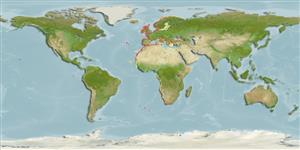Common names from other countries
Classification / Names / Names
Noms communs | Synonymes | Catalog of Fishes (gen., sp.) | ITIS | CoL | WoRMS
Environment: milieu / climate zone / depth range / distribution range
Écologie
Démersal; eau douce; saumâtre; profondeur 0 - 29 m (Ref. 125465). Temperate; ? - 30°C (Ref. 125465)
Distribution
Pays | Zones FAO | Écosystèmes | Occurrences | Introductions
Atlantic, Black Sea and the Mediterranean. Temperate to subtropical.
Length at first maturity / Taille / Poids / Âge
Maturity: Lm ? range ? - ? cm
Known from depths of 0 to <50 m. Euryhaline. May tolerate freshwater conditions. Found in shallow brackish and estuarine waters, sometimes offshore; shows diurnal vertical migrations (Ref. 85342).
Life cycle and mating behavior
Maturité | Reproduction | Frai | Œufs | Fécondité | Larves
Members of the order Mysida are gonochoric. Mating behavior: Male inserts the penis into the marsupium and releases sperm; eggs are then released from the oviducts into the marsupium where fertilization occurs. Life cycle: Eggs are brooded in the marsupium and later hatch into miniature adults, no postlarva.
Healy, B. 1997. (Ref. 2779)
Statut dans la liste rouge de l'IUCN (Ref. 130435)
statut CITES (Ref. 108899)
Not Evaluated
Not Evaluated
Utilisations par l'homme
| FishSource |
Outils
Plus d'informations
Taille/Âge
Croissance
Longueur-poids
Longueur-longueur
Morphologie
Larves
Abondance
Sources Internet
Estimates based on models
Preferred temperature
(Ref.
115969): 9.4 - 19.6, mean 14.2 (based on 833 cells).
Catégorie de prix
Unknown.
